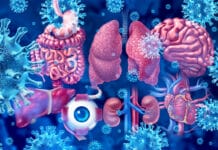Hepatitis is an inflammation of the liver that ranges from minimal symptoms to severe liver failure. Hepatitis is mainly viral with the common A, B, and C strains and these strains are the ones dental professionals are mostly aware of. Other hepatitis categories include infectious, metabolic, autoimmune, genetic, and ischemic.
As discussed below, the dental management of hepatitis patients is very important. Also, as most dental professionals are aware, infection control practices are developed to minimize infection to the caregiver.
Knowing which hepatitis a patient has or had will help determine if any additional precautions are needed. According to the American Dental Association, dental providers are at a three- to four-fold risk of contracting the hepatitis B virus compared to the general population. The hepatitis B vaccine that we are required to have as dental professionals and the precautionary methods we take greatly decreases the risk of obtaining the virus.5 According to the Centers for Disease Control and Prevention, completing the series of vaccine shots for the hepatitis B virus protects us from becoming infected.18
This then leaves us more at occupational risk of infection from hepatitis C. In dentistry, hepatitis C is mainly incurred by a percutaneous injury such as from a needlestick or sharp instrument. With this risk, there’s a 1.8% risk of getting an infection. Hepatitis C has been detected in saliva, but there hasn’t been a documented case of salivary transmission.5 Implementing proper infection and sterilization measures and documenting a thorough medical history will increase the greatest results when dealing with these infectious viruses.
Severity of Hepatitis
Hepatitis is either acute or chronic. This is a global disease, and World Hepatitis Day is observed on June 28th to raise global awareness of hepatitis.
Acute hepatitis − Acute hepatitis is generally caused by viral infections and resolves within six months. It will usually resolve on its own, progress to a chronic state, or result in acute liver failure.1 It’s characterized by affecting many different body systems.
The initial phase includes flu-like symptoms: fatigue, nausea, vomiting, poor appetite, joint pain, and headaches, which are similar symptoms to other viral infections. Fever tends to be more common in hepatitis A and E. Late in this phase, liver-specific symptoms such as dark urine and clay-colored stools may be experienced.
The second phase is jaundice after about one to two weeks from the initial phase and may last up to four weeks. An enlarged liver and right upper abdominal pain may increase. Unintentional weight loss is likely.
The recovery phase is the resolution of all clinical symptoms, but increased liver lab values and a persistently enlarged liver remain.
Fulminant hepatitis − quick and sudden liver failure − is rare and mainly occurs in hepatitis B, D, and E. About one to two percent of hepatitis E can lead to fulminant hepatitis, and pregnant women are more susceptible, occurring in 20% of cases.1
Type of Hepatitis
Chronic hepatitis − Chronic hepatitis is inflammation that continues for more than six months, presenting similar to acute hepatitis but mainly manifests signs and symptoms specific to the liver.
Having chronic hepatitis may not initially expose symptoms since the virus can lay dormant in cells. It may not reveal symptoms until years after contracting hepatitis. It causes dysfunction of the liver and long-term inflammation and eventually damages the liver or leads to death. Chronic hepatitis is most common with hepatitis B and C.2
Infectious hepatitis − Viral hepatitis infections are the common ones we hear about, such as A, B, C, D, and E. The symptoms for viral hepatitis are generally the same throughout:
- Fatigue
- Sudden nausea and vomiting
- Abdominal pain, especially on the right side beneath the lower ribs near the liver
- Clay-colored bowel movements
- Dark urine
- Loss of appetite
- Low-grade fever3
Hepatitis A (HAV) − Hepatitis A is a highly contagious liver infection that infects liver cells and causes inflammation. It is found globally and tends to lead to outbreaks since it’s correlated with contaminated water and food sources.
Hepatitis A is also spread when fecal matter is ingested from contact with foods, drinks, or objects through improper handwashing or sanitary issues. Eating raw shellfish from a polluted source, being in close contact and sexually involved with an infected person also spreads the virus.3
Symptoms last between a few weeks to a few months. The hepatitis A virus, unlike other hepatitis viruses, is mainly acute and does not cause long-term liver damage.4,5
Hepatitis B (HBV) − Hepatitis B is a vaccine-preventable liver infection. This is spread through infected blood by sharing needles, syringes, other drug-injection equipment, and even toothbrushes and razors. Hepatitis B is also spread through sexual contact and may be passed from mother to baby during pregnancy and childbirth.
Jaundice may be present in this form of this virus. Hepatitis B can last a few weeks or lead to a serious chronic condition. It’s a short-term illness for many people, although it may be chronic and life-threatening with cirrhosis or liver cancer for others. The risk for chronic infection determines with age; two to six percent of infected adults will become chronically infected, and 90% of infants will develop a chronic condition.6
Hepatitis C (HCV) − Hepatitis C causes liver inflammation and is the major cause of liver cirrhosis and hepatocellular carcinoma. Causes include being exposed to infected blood through high-risk sexual behavior, needles, blood transfusions or transplants, unclean and unsterile equipment for drug injections, and tattoos or piercings.
Additional symptoms from the general ones listed above are jaundice, abdominal fluid buildup, weight loss, spider-like blood vessels on the skin, easy bruising and bleeding, and confusion. By the time symptoms are noticed, the virus is usually into the advanced stage.7,8
Hepatitis C starts in the acute phase and may progress to a serious chronic infection if not treated early. This is a silent virus, and people will be asymptomatic and not realize they have it until decades later when liver complications start to happen.
Hepatitis C is still contagious even if symptoms are not present. The earlier this virus is detected, the higher the success rate of treatment and recovery. For this reason, the U.S. Preventative Services Task Force recommends adults ages 18-79 be screened for hepatitis C. The largest risk group comprises people born between 1945-1965, and they are five times more likely to have this virus. HIV patients and prison inmates, present or previously, are at a higher risk of contracting hepatitis C.7,8
Hepatitis D (HDV) − Hepatitis D is liver inflammation and infection that only affects people who are already infected with hepatitis B. This virus can be contracted at the same time hepatitis B is or after the fact. It is spread through infected blood or other bodily fluids.
The virus may be an acute, short-term infection, or it can become a chronic, long-term infection leading to lifelong liver damage and even death.9
Hepatitis E (HEV) − Hepatitis E is a liver infection and is similar to hepatitis A by manifestation from contaminated fecal and water sources. This virus is found in the stools of an infected person. It’s commonly spread in the United States by eating raw or undercooked pork, venison, wild boar meat, or shellfish. In developing countries, it’s commonly spread from drinking water contaminated with feces.
Most people fully recover from this virus without any complications. Children who are infected with hepatitis E rarely even have symptoms.10
Parasitic hepatitis − Parasitic hepatitis affects the liver through parasites and worms. Likewise, these subjects affect the bile ducts and gallbladder. Liver flukes or single-cell parasites commonly live in the soil, water, or various animals’ digestive tracts. These hepatitis-causing parasites that cause liver inflammation may be contracted from raw leafy vegetables or insufficiently cooked meats.11
Bacterial hepatitis − Bacterial hepatitis infects the liver by causing damage and inflammation to it. Common bacteria are Escherichia coli, salmonella, or meningococcus. These bacteria come from comminated food, water, fleas, and ticks.
Bacterial hepatitis is both an acute and chronic types of hepatitis. Treatment for this is antibiotics and bed rest.11
Metabolic hepatitis − Metabolic hepatitis is formed from metabolic substances.
Toxic and drug-induced hepatitis − Many drugs can cause inflammation of the liver. Medications, toxins, and herbal and dietary supplements are culprits of causing hepatitis. Drug-induced liver hepatitis ranges from acute to chronic hepatitis to acute liver failure.
Hepatitis induced from medications or toxins is by direct cell damage, disruption of cell metabolism, and structural changes. Herbal and dietary supplements can cause hepatotoxicity (damage or destruction to the liver cells).
Medications that cause chronic hepatitis are isoniazid (tuberculosis), methyldopa (high blood pressure), phenytoin (seizures), and nitrofurantoin (urinary tract infections).2
Alcoholic hepatitis − Alcoholic hepatitis is inflammation of the liver caused by moderate to heavy, consistent consumption of alcohol. The body reacts to the alcohol causing hepatitis by breaking down alcohol to produce highly toxic chemicals that trigger inflammation and destroy liver cells.
Over time, scars replace healthy liver tissue interfering with proper liver function. This irreversible scarring, known as cirrhosis, is the final stage of alcoholic liver disease.
The most common symptom is jaundice. Additional symptoms are loss of appetite, nausea, vomiting, abdominal tenderness, low-grade fever, fatigue, and weakness. Other symptoms with severe alcoholic hepatitis include fluid accumulation in the abdomen, kidney and liver failure, confusion, and behavior changes. Along with heavy drinking, other risk factors include sex (women process alcohol differently than men), obesity, and binge drinking. African Americans and Hispanics are at higher risk.12
Nonalcoholic steatohepatitis − Nonalcoholic steatohepatitis is also known as fatty liver disease. Although this resembles alcoholic hepatitis, this condition forms with very minimal or no alcohol consumption. The main feature is fat, inflammation, and damage to the liver.
It is not fully understood what causes nonalcoholic steatohepatitis. Some suggestions are insulin resistance, the release of toxic inflammatory proteins by fat cells, and oxidative stress inside the liver cells. Other suggestions are excess belly fat, hypertension, hyperglycemia, high cholesterol levels, obesity, and diabetes.
Most people are unaware they have this condition and become aware after routine blood tests. A definitive diagnosis is a liver biopsy.13
Other Types of Hepatitis
- Autoimmune hepatitis: Autoimmune hepatitis is when the body forms antibodies to attack its own liver cells. The immune system mistakes the liver as harmful and causes ongoing mild to severe inflammation that eventually hinders proper liver function.
- Type 1 autoimmune hepatitis: The most common type and occurs at any age. About 50% of this type have other autoimmune diseases.
- Type 2 autoimmune hepatitis: This occurs at any age yet more so in children and young people. May have other autoimmune diseases.14
Autoimmune hepatitis risk factors are being female (three times more common in women than men) and heredity (there may be a predisposition in families for this). A history of infections with measles, herpes simplex, or Epstein-Barr virus. Autoimmune hepatitis may have an increased risk with other autoimmune diseases such as rheumatoid arthritis, celiac disease, and hyperthyroidism.3
Genetic hepatitis − Genetic hepatitis is an inherited medical condition that affects normal liver function and causes liver inflammation. A few medical conditions involve abnormal storage of minerals. Hemochromatosis causes the body to accumulate too much iron and, in effect, disturbs the heart, pancreas, and liver. Wilson’s disease stores an excess of copper in the brain and liver. Both conditions cause cirrhosis.2,11
Ischemic hepatitis − Ischemic hepatitis is also known as shock liver. This is from reduced or inadequate blood flow and supply to the liver. Reasons for this may be heart or respiratory failure or when both the hepatic artery and the portal vein are blocked.
Ischemic hepatitis will resolve on its own and rarely causes permanent liver damage. Treating the underlying conditions, such as getting blood flow back to the liver, will restore the liver.15
Hepatitis Treatment
Hepatitis is diagnosed by a physical exam and risk factors involved. The medical doctor will look for jaundice, feel for an enlarged liver, and check for pain or tenderness in the abdominal area. Liver function tests involving blood work are also used and checked for high liver enzymes, which may indicate the liver is stressed, damaged, or improper liver function. Other blood tests will check for hepatitis viruses or antibodies with autoimmune hepatitis.
An ultrasound may be used to evaluate fluid in the abdomen, liver damage, enlargement or tumors, and abnormalities of the gallbladder. A liver biopsy is conducted by a sample of liver tissue being extracted and examined. This determines the degree of inflammation and infection affecting the liver.3
Hepatitis Vaccinations
Hepatitis A, B, and D are preventable with vaccinations. For hepatitis A and B, vaccinations are given at any age. Vaccinations are recommended for people with higher risk lifestyles and activities which may contract these viruses.5 These lifestyles include unprotected and multiple sex partners, drug use especially intravenous, regular international travel, inmates, and sharing personal items with an infected person.
There are a series of two vaccines for hepatitis A and B, and they can be combined. Although there is no vaccination for hepatitis D, it can be addressed by having the hepatitis B vaccination.16 There is no vaccination for hepatitis C.
Antiviral Hepatitis Medications
Antiviral medications are recommended with chronic Hepatitis B and C. There is no specific treatment for nonalcoholic steatohepatitis, although exercise, a healthy diet, and weight loss are suggested.
Autoimmune hepatitis may be treated with medications to suppress the immune system. Such medications are tacrolimus, cyclosporine, and azathioprine, which may be used with steroids.
Healthy Lifestyle & Hepatitis
A healthy lifestyle goes a long way. Avoidance of the risk factors stated above that promote hepatitis is a key factor. Practicing good habits with proper hygiene, healthy eating, and regular exercise are also beneficial.
Dental Concerns of Hepatitis
The goal is to prevent the spread of bloodborne pathogens and aerosols between patients and patients to the dental provider in the operatory. Although bloodborne pathogens can be transmitted through mucous membranes, according to the CDC, there are no known instances of bloodborne pathogens transmitted by an aerosol in the dental environment. Hepatitis is spread through direct contact with saliva, blood, or bodily fluids − not by aerosols.17
Dental management is important for hepatitis patients. A patient with acute viral hepatitis should be limited to urgent care.5 Dental manifestations of hepatitis with liver dysfunction may include mucosal membrane jaundice, bleeding disorders, petechiae, gingivitis, bleeding gingiva, cheilitis, smooth and atrophic tongue, xerostomia, bruxism, crusted perioral rash, and fetor hepaticus.
Liver disease may cause decreased plasma coagulation. It may also result in adjustments to certain medications due to metabolism.5
Fetor hepaticus is a sign of advanced liver disease often associated with hepatitis or cirrhosis. The liver is not able to filter toxins as well, so sulfur travels into the bloodstream and into the lungs giving the exhale breath a distinct smell. It may be a strong, musty smell or a smell that resembles rotten eggs and garlic. This mouth odor of dimethyl sulfide has been described as the breath of the dead. To treat fetor hepaticus is to treat the liver disease. At this point, this is challenging since the liver disease is in its advanced stage.16
Hepatitis Infection Control
For hepatitis B and C, infection control is important to implement strict disinfecting and sterilizing protocols. Hepatitis C can survive at room temperature on surfaces for more than five days, while hepatitis B survives for at least a week.5 If a needle stick or sharps injury occurs, post-exposure evaluation and follow-up are important if hepatitis is involved.
In dentistry, we deal with numerous patients and are exposed to blood. We are at a high risk of infection. Knowing that a patient may not be aware of having the hepatitis virus is where standard precautions are especially important to follow. Standard precautions are intended to stop the spread of infections between patients and other patients as well as between patients and dental providers.
Now Listen to the Today’s RDH Dental Hygiene Podcast Below:
References
- Bernal, W., Wendon, J. Acute Liver Failure. The New England Journal of Medicine. 2013; 369(26): 2525–2534. Retrieved from https://www.nejm.org/doi/10.1056/NEJMra1208937
- Chronic Hepatitis. (2020, August 17). Drugs.com. Retrieved from https://www.drugs.com/health-guide/chronic-hepatitis.html.
- Kahn, A. Hepatitis. (2017, May 9). Healthline. Retrieved from https://www.healthline.com/health/hepatitis#treatment.
- Hepatitis A. (2020, August 28). Mayo Clinic. Retrieved from https://www.mayoclinic.org/diseases-conditions/hepatitis-a/symptoms-causes/syc-20367007.
- Hepatitis Viruses. (2019, March 26). American Dental Association. Retrieved from https://www.ada.org/en/member-center/oral-health-topics/hepatitis-viruses.
- Hepatitis B. (2020, June 22). Centers for Disease Control and Prevention. Retrieved from https://www.cdc.gov/hepatitis/hbv/index.htm.
- Hepatitis C. (2020, July 28). Centers for Disease Control and Prevention. Retrieved from https://www.cdc.gov/hepatitis/hcv/.
- Hepatitis C. (2020, March 20). Mayo Clinic. Retrieved from https://www.mayoclinic.org/diseases-conditions/hepatitis-c/symptoms-causes/syc-20354278.
- Hepatitis D. (2020, June 22). Centers for Disease Control and Prevention. Retrieved from https://www.cdc.gov/hepatitis/hdv/.
- Hepatitis E. (2020, June 22). Centers for Disease Control and Prevention. Retrieved from https://www.cdc.gov/hepatitis/hev/.
- Lixandru, M. 7 types of Non-viral Hepatitis Parasitic Hepatitis. (2017, July 15). Nature Word. Retrieved from https://www.natureword.com/tag/parasitic-hepatitis/.
- Alcoholic Hepatitis. (2018, November 30). Mayo Clinic. Retrieved from https://www.mayoclinic.org/diseases-conditions/alcoholic-hepatitis/symptoms-causes/syc-20351388.
- Nonalcoholic Steatohepatitis. (2012, February 24). U.S. Department of Health & Human Services: Genetic and Rare Diseases Information Center. Retrieved from https://rarediseases.info.nih.gov/diseases/6430/nonalcoholic-steatohepatitis.
- Autoimmune Hepatitis. (2020, April 17). Mayo Clinic. Retrieved from https://www.mayoclinic.org/diseases-conditions/autoimmune-hepatitis/symptoms-causes/syc-20352153.
- Jackson, W.E. Ischemic Hepatitis. (2020, May). Merck Manual Consumer Version. Retrieved from https://www.merckmanuals.com/home/liver-and-gallbladder-disorders/blood-vessel-disorders-of-the-liver/ischemic-hepatitis.
- Moyer, N. Fetor Hepaticus. (2018, September 18). Healthline. Retrieved from https://www.healthline.com/health/fetor-hepaticus#treatment.
- Blood Pathogen and Aerosols. (2020, January 2). Centers for Disease Control and Prevention. Retrieved from https://www.cdc.gov/oralhealth/infectioncontrol/faqs/bloodborne-exposures.html.
- Hepatitis B Questions and Answers for the Public. (2020, July 28). Centers for Disease Control and Prevention. Retrieved from https://www.cdc.gov/hepatitis/hbv/bfaq.htm#bFAQd01.












